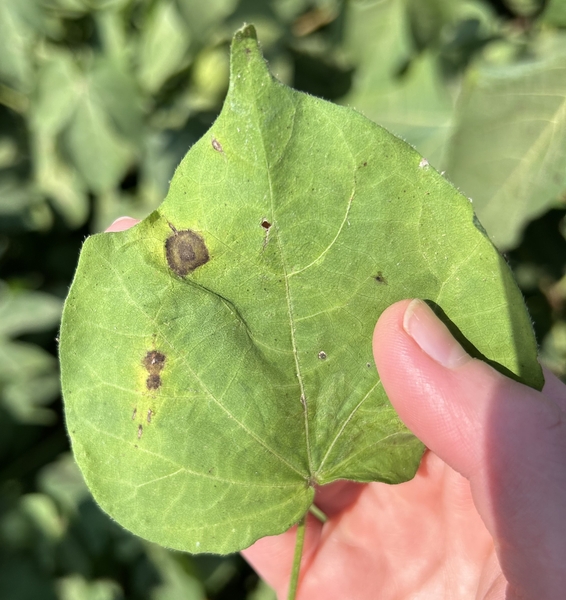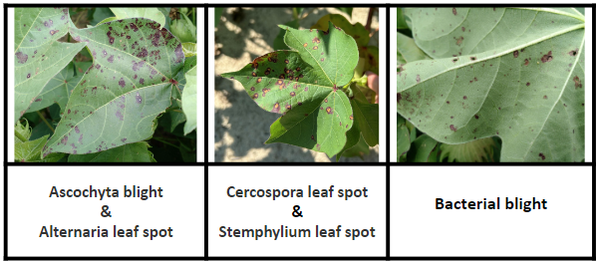Introduction
Areolate mildew, originating in Alabama in 1890, and target spot, first described in Mississippi in 1959, have both become increasingly prevalent across the southeastern United States over the past three decades. Significant yield losses have been reported in Alabama, Georgia, and Florida. While these diseases have occurred sporadically in North Carolina, significant yield losses have not been reported in the state. The diseases are often associated with each other, likely due to similar environmental conditions favoring their development. Areolate mildew was first reported in North Carolina in 2018 during a year with unusually high rainfall, while target spot was found in North Carolina in 2012.
Pathogens
- Areolate mildew (downy mildew or false mildew) is caused by the fungus, Ramulariopsis gossypii and possibly R. pseudoglycines.
- Target spot is caused by the fungus, Corynespora cassicola.
Signs and Symptoms
Areolate mildew first starts as brown lesions on the lower canopy leaves. The lesions will grow up to ~0.15 in wide and will be restricted by a major leaf vein. The lesions are slightly chlorotic (yellowed) or necrotic on the upper leaf surface, resembling bacterial blight. A characteristic sign of the disease is the white, powdery, mildew growth on the lower surface of the leaves (Figure 1). As the disease develops, the lower canopy of the infected plant will defoliate prematurely and the upper canopy may develop symptoms.
Target spot first starts as brown lesions on the lower canopy leaves. As the lesions grow up to 1 inch in diameter, the rings will develop irregular concentric rings, giving the lesions their characteristic ‘target’ look (Figure 2). As the disease develops, the lower canopy of the infected plant will defoliate prematurely and the upper canopy may develop symptoms. As lesions age, centers of leaf spots may fall out causing a shot-hole appearance.
Other leaf spot diseases that may appear throughout the growing season are often associated with nutrition deficiencies and environmental stress, and do not warrant intervention (Table 1, Figure 3).
| Disease | Causal Agent |
|---|---|
| Ascochyta blight | Ascochyta gossypii |
| Alternaria leaf spot | Alternaria spp. |
| Bacterial blight/angular leaf spot | Xanthomonas axonopodis pv. malvacearum |
| Cercospora leaf spot | Cercospora gossypina |
| Stemphylium leaf spot | Stemphylium solani |
Disease Cycle
Ramulariopsis spp. oospores and Corynespora cassicola chlamydospores can overwinter in plant debris and soil for several years. When conditions are favorable (25-30F, >85% humidity), Ramulariopsis oospores produce motile zoospores, and Corynespora chlamydospores generate conidia. The spores are dispersed by rain, irrigation, or wind. When spores land on cotton leaves, they will germinate and infect the leaf tissue. As the pathogen grows, dead tissue begins to form a lesion. Corynespora fruiting bodies (stroma) emerge from infected leaves, while Ramulariopsis sporangia erupt from stomata on the leaves' undersides, creating the white, powdery disease sign. The spores produced by the stroma and sporangia may spread further, leading to ongoing disease development. Both fungal pathogens are polycyclic, continuously growing, reproducing, and spreading from infected leaves as long as conditions are favorable.
Disease Management
Crop Debris Destruction
- Destroy all crop debris from fields, as soon after harvest as possible. Till debris as deep into the soil as possible, while managing soil erosion.
-
Burning is not an effective control method as it only removes the debris on the surface. If burning is used to remove excess debris, it should be combined with tillage to push debris to deeper levels of soil.
-
Sanitizing and rinsing equipment to remove soil and spores after use is good practice for managing most diseases.
-
Ensure that runoff water does not run into 'clean' fields.
-
Crop Rotation
-
Crop rotation can suppress the population of some leaf spot diseases, such as areolate mildew and bacterial blight.
-
The target spot pathogen can infect a wide range of hosts, including soybeans, cucurbits, and tomatoes. Rotations with these crops should be avoided after high target spot incidences.
Planting and Growing season
-
Reduce nutrient stress through proper fertilization.
-
Avoid practices that result in a rank, dense canopy.
-
Lower seeding density or space plants out properly to promote air flow
-
Use a growth regulator to reduce plant height.
-
-
Scout for leaf spot diseases by checking the lower canopy of plants during the first week of bloom.
-
Check field in a zig-zag pattern.
-
If symptoms are not seen, scout again within 2 weeks.
-
Chemical Control
-
Foliar diseases are rarely severe enough for foliar sprays to be economical.
-
Fields that are beyond the 6th week of bloom, fully cutout with fairly mature bolls, and within ~4 weeks from defoliation, a fungicide application may not be warranted.
-
-
If excessive target spot lesions or areolate mildew are present with a forecast of prolonged rain, consider a fungicide spray to manage defoliation.
-
If not scouting, a fungicide spray may be effective between the 3rd and 4th week of bloom (Table 2).
-
For annually updated chemical management tools, consult the North Carolina Agricultural Chemical Manual.
| FRAC | Fungicide | Rate (fl oz/a) | Remarks |
|---|---|---|---|
|
7,11
|
Elatus*
|
5-7.3
|
45 day PHI
|
|
3,7
|
Miravis Top
|
13.6
|
45 day PHI
|
|
7,11
|
Priaxor
|
4-8
|
30 day PHI
|
|
11
|
Quadris
|
6-9
|
45 day PHI
|
|
3,7,11
|
Revytek
|
8-15
|
30 day PHI
|
|
3
|
Topguard EQ
|
5-7
|
12 hour REI. 45 day PHI
|
* Not labeled for areolate mildew in NC
Useful Resources
-
The NC State University Plant Disease and Insect Clinic provides diagnostics and control recommendations.
-
The NC State Extension Plant Pathology Portal provides information on crop disease management.
-
The North Carolina Agricultural Chemicals Manual provides pesticide information for common diseases of North Carolina. The manual recommendations do not replace those described on the pesticide label, and the label must be followed.
-
For assistance with a specific problem, contact your local N.C. Cooperative Extension agent.
Publication date: Oct. 12, 2023
Reviewed/Revised: Dec. 2, 2024
N.C. Cooperative Extension prohibits discrimination and harassment regardless of age, color, disability, family and marital status, gender identity, national origin, political beliefs, race, religion, sex (including pregnancy), sexual orientation and veteran status.
NC Cooperative Extension prohíbe la discriminación por raza, color, nacionalidad, edad, sexo (incluyendo el embarazo), discapacidad, religión, orientación sexual, identidad de género, información genética, afiliación política, y estatus de veteran.
Recommendations for the use of agricultural chemicals are included in this publication as a convenience to the reader. The use of brand names and any mention or listing of commercial products or services in this publication does not imply endorsement by NC State University or N.C. A&T State University nor discrimination against similar products or services not mentioned. Individuals who use agricultural chemicals are responsible for ensuring that the intended use complies with current regulations and conforms to the product label. Be sure to obtain current information about usage regulations and examine a current product label before applying any chemical. For assistance, contact your local N.C. Cooperative Extension county center.
N.C. Cooperative Extension prohibits discrimination and harassment regardless of age, color, disability, family and marital status, gender identity, national origin, political beliefs, race, religion, sex (including pregnancy), sexual orientation and veteran status.



